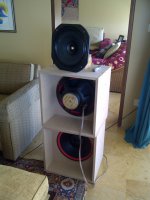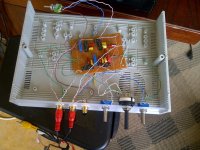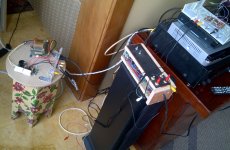Weeks of research and limited availability of equipment where I live has led me to try my hand at building a PLLXO for my cheap 2-way H-Frame OB project.
The OB project is just a test as I wanted to see what kind of performance is to be expected from such a setup, and I had all the drivers needed on hand (Audio Nirvana Super 12 for full range, and some no-name brand 15 inch woofers for bass support).
I first had my mind set on getting a MiniDSP for Xover duty, put after reading Bob Brines' comment about the MiniDSP's 3rd order harmonic distortion, I decided to hold back for a while and go with a simple PLLXO.
In order to test multiple crossover points and both 1st and second order slopes, I constructed a proto board with dip switches. This way I could switch on the fly between crossover points.
My setup is as follows:
-PC as a source
-Lighternote passive pre for volume control.
-PLLXO
-High pass goes to tube buffered 41hz Amp6 and then to AN super 12
-Low pass goes to Teac receiver and then to parallel wired pair of woofers in H-Frame
PLLXO:
the xover is based on the article found on TLS.org | Passive Line-Level Crossover and the Excel sheet found over there.
I have set R1 and R2 for both Low Pass and High Pass to 5k and 50k respectively, and made the capacitor value selectable through the dip switches.
A quick RMAA test showed the PLLXO to behave relatively cleanly, with minimal noise.
As you can see in the PLLXO pic below, the capacitors are a mixture of ceramic, paper and polyester. That's all that I could find over here (high end audio DIY is not exactly rampant over here)
Now that I've had some time to listen to the setup, I think that my crossover points are screwed, this is my 4th day of testing and things are starting to improve.
I have a few noob caliber questions regarding some aspects of the PLLXO:
- What should the caps' voltage rating be? the smallest I have found were 63V, but others were 400V, are there any detrimental effects to using higher voltage rated caps?
- I selected R1 and R2 based solely on a what was available. Is there any way to optimize them?
- I find that the high pass section when using a 2nd order slope sound pretty bad. Any idea why that could be? I'm using a tube buffer between the PLLXO and according to the schematics (decware Zkit 4), this should have a 1Megaohm input impedance (first resistor to ground).
Sorry for the long post and the avalanche of questions, but I could do with any input I can get.
P.S: don't judge the looks of the setup, I said "quick and dirty", consider it a disclaimer 🙂 but then again maybe I should have said "Quick, Dirty and really really Ugly"
The OB project is just a test as I wanted to see what kind of performance is to be expected from such a setup, and I had all the drivers needed on hand (Audio Nirvana Super 12 for full range, and some no-name brand 15 inch woofers for bass support).
I first had my mind set on getting a MiniDSP for Xover duty, put after reading Bob Brines' comment about the MiniDSP's 3rd order harmonic distortion, I decided to hold back for a while and go with a simple PLLXO.
In order to test multiple crossover points and both 1st and second order slopes, I constructed a proto board with dip switches. This way I could switch on the fly between crossover points.
My setup is as follows:
-PC as a source
-Lighternote passive pre for volume control.
-PLLXO
-High pass goes to tube buffered 41hz Amp6 and then to AN super 12
-Low pass goes to Teac receiver and then to parallel wired pair of woofers in H-Frame
PLLXO:
the xover is based on the article found on TLS.org | Passive Line-Level Crossover and the Excel sheet found over there.
I have set R1 and R2 for both Low Pass and High Pass to 5k and 50k respectively, and made the capacitor value selectable through the dip switches.
A quick RMAA test showed the PLLXO to behave relatively cleanly, with minimal noise.
As you can see in the PLLXO pic below, the capacitors are a mixture of ceramic, paper and polyester. That's all that I could find over here (high end audio DIY is not exactly rampant over here)
Now that I've had some time to listen to the setup, I think that my crossover points are screwed, this is my 4th day of testing and things are starting to improve.
I have a few noob caliber questions regarding some aspects of the PLLXO:
- What should the caps' voltage rating be? the smallest I have found were 63V, but others were 400V, are there any detrimental effects to using higher voltage rated caps?
- I selected R1 and R2 based solely on a what was available. Is there any way to optimize them?
- I find that the high pass section when using a 2nd order slope sound pretty bad. Any idea why that could be? I'm using a tube buffer between the PLLXO and according to the schematics (decware Zkit 4), this should have a 1Megaohm input impedance (first resistor to ground).
Sorry for the long post and the avalanche of questions, but I could do with any input I can get.
P.S: don't judge the looks of the setup, I said "quick and dirty", consider it a disclaimer 🙂 but then again maybe I should have said "Quick, Dirty and really really Ugly"
Attachments
Just a couple of thoughts... no need to use the high voltage rated caps at line level, physically larger and more $$$. I suspect you would need a buffer between that Lighter Note and the PLLXO for this to work well. I'm assuming the input impedance is low on that Amp6, hence the buffer there, but I'm not familiar with it. I think I would stay away from the ceramic caps, especially in series. Your R1 and R2 values should be alright with a low impedance in front (buffer), and high R_amp values.
I played around with a 1st order HP PLLXO that seemed to work well, but maybe someone with more experience will chime in here with some more/better suggestions hopefully.
If the PLLXO just isn't going to work well with your particular setup, there's always the "old school" analog active's like the Marchand XM1 or one of Rod Elliot's offerings.
I played around with a 1st order HP PLLXO that seemed to work well, but maybe someone with more experience will chime in here with some more/better suggestions hopefully.
If the PLLXO just isn't going to work well with your particular setup, there's always the "old school" analog active's like the Marchand XM1 or one of Rod Elliot's offerings.
2nd order HP are tricky. R2 is in parallel with the tube buffer's input impedance... use that as R2.
The other issue is that the output impedance of the passive pre is likely very high.
On 1st blush you need a buffer after the passive pre, but you might be able to get away with R1 = 100k, R2 = input impedance of Zkit as R2 = 1 Mohm
dave
The other issue is that the output impedance of the passive pre is likely very high.
On 1st blush you need a buffer after the passive pre, but you might be able to get away with R1 = 100k, R2 = input impedance of Zkit as R2 = 1 Mohm
dave
Dave and William, thanks for chiming in.
I have been doing some listening as well as some freq response sweeps of the PLLXO (not the OB setup as I'm still waiting for my measurement rig) using both REW and RMAA, these sweeps show a lot of noise when using 2nd order slopes both for the HP and LP sections (I'll post a pic shortly to show the difference)
For a moment I thought my speakers were sounding OK, but they actually sound horrible (that's what happens when you spend a whole week trying to tweak your speakers while not listening to a "reference" pair) as I bought a pair of KEF 105.2 that showed me how bad my OB setup sounded 🙂
Ok, so, next step:
Look for a clean sounding Buffer as this seems to be the consensus.
I'm guessing a Diy Pass B-1 should do the trick, right?
I have been doing some listening as well as some freq response sweeps of the PLLXO (not the OB setup as I'm still waiting for my measurement rig) using both REW and RMAA, these sweeps show a lot of noise when using 2nd order slopes both for the HP and LP sections (I'll post a pic shortly to show the difference)
For a moment I thought my speakers were sounding OK, but they actually sound horrible (that's what happens when you spend a whole week trying to tweak your speakers while not listening to a "reference" pair) as I bought a pair of KEF 105.2 that showed me how bad my OB setup sounded 🙂
Ok, so, next step:
Look for a clean sounding Buffer as this seems to be the consensus.
I'm guessing a Diy Pass B-1 should do the trick, right?
Look for a clean sounding Buffer as this seems to be the consensus.
I'm guessing a Diy Pass B-1 should do the trick, right?
There is at least 1 thread here on using the B1 buffer circuit to create a buffered PLLXO
dave
Grey Rollins has some interesting articles like this one: The Xenover - Part II Article And Design By Grey Rollins
This jfet buffer sandwich looks simple enough to do on perfboard. But take note that his 2nd order is Sallen-Key which some folks may not like. But at least the filter itself would be behaving as it should now that it's loaded properly.
This jfet buffer sandwich looks simple enough to do on perfboard. But take note that his 2nd order is Sallen-Key which some folks may not like. But at least the filter itself would be behaving as it should now that it's loaded properly.
- Status
- Not open for further replies.


